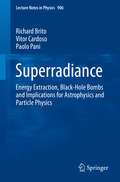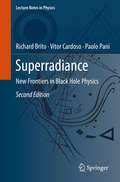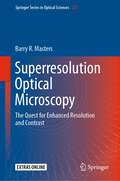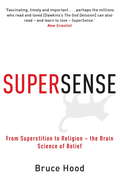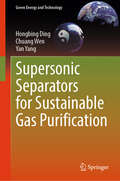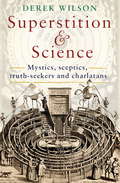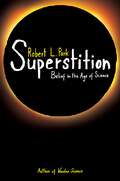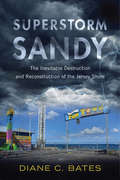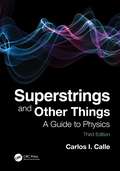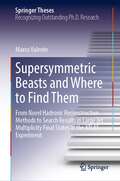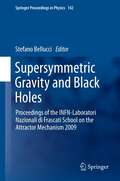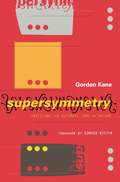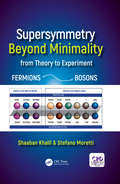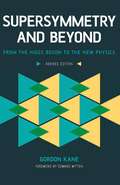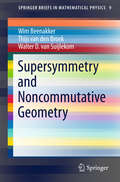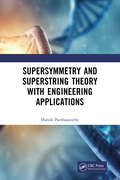- Table View
- List View
Superquake!: Why Earthquakes Occur and When the Big One Will Hit Southern California
by David RitchieIt's coming, sometime within your lifetime, as inexorably as approaching thunder--the biggest earthquake to hit the West Coast since San Francisco was demolished in 1906. This time the target most likely will be southern California and the sprawling, populous city of Los Angeles. And this time the devastation will be greater than ever before, because in the eighty-odd years since the last great quake we have become so much more dependent on our technology. It won't be just toppled buildings and broken roads this time, but the complete disruption of transportation and communication systems, the breakdown of medical services, the destruction of water resources, widespread spilling of toxic chemicals and volatile fuels, and the leakage of radioactive materials. Angelenos can forget about the bomb; they are building their future in the shadow of an equally destructive and much more inevitable catastrophe. Science writer David Ritchie takes a hard look at the evidence predicting a devastating earthquake for southern California sometime within the next fifty years. What causes earthquakes, and how can earth scientists be so certain that a major earthquake is coming? Ritchie surveys the history of California quakes and shows that, while individual generations of Californians may escape catastrophe, on a geologic time scale the West Coast is highly unstable and ripe for disaster.
Superradiance
by Richard Brito Vitor Cardoso Paolo PaniThis volume gives a unified picture of the multifaceted subject of superradiance, with a focus on recent developments in the field, ranging from fundamental physics to astrophysics. Superradiance is a radiation enhancement process that involves dissipative systems. With a 60 year-old history, superradiance has played a prominent role in optics, quantum mechanics and especially in relativity and astrophysics. In Einstein's General Relativity, black-hole superradiance is permitted by dissipation at the event horizon, which allows energy extraction from the vacuum, even at the classical level. When confined, this amplified radiation can give rise to strong instabilities known as "blackhole bombs'', which have applications in searches for dark matter, in physics beyond the Standard Model and in analog models of gravity. This book discusses and draws together all these fascinating aspects of superradiance.
Superradiance: New Frontiers in Black Hole Physics (Lecture Notes In Physics Series #971)
by Richard Brito Vitor Cardoso Paolo PaniThis book focuses on one mechanism in black hole physics which has proven to be universal, multifaceted and with a rich phenomenology: rotational superradiance. This is an energy extraction process, whereby black holes can deposit their rotational energy in their surroundings, leading to Penrose processes, black-hole bombs, and even Hawking radiation. Black holes are key players in star formation mechanisms and as engines to some of the most violent events in our universe. Their simplicity and compactness make them perfect laboratories, ideally suited to probe new fields or modifications to the theory of gravity. Thus, black holes can also be used to probe some of the most important open problems in physics, including the nature of dark matter or the strong CP problem in particle physics. This monograph is directed to researchers and graduate students and provides a unified view of the subject, covering the theoretical machinery, experimental efforts in the laboratory, and astrophysics searches. It is focused on recent developments and works out a number of novel examples and applications, ranging from fundamental physics to astrophysics. Non-specialists with a scientific background should also find this text a valuable resource for understanding the critical issues of contemporary research in black-hole physics. This second edition stresses the role of ergoregions in superradiance, and completes its catalogue of energy-extraction processes. It presents a unified description of instabilities of spinning black holes in the presence of massive fields. Finally, it covers the first experimental observation of superradiance, and reviews the state-of-the-art in the searches for new light fields in the universe using superradiance as a mechanism.
Superresolution Optical Microscopy: The Quest for Enhanced Resolution and Contrast (Springer Series in Optical Sciences #227)
by Barry R. MastersThis book presents a comprehensive and coherent summary of techniques for enhancing the resolution and image contrast provided by far-field optical microscopes. It takes a critical look at the body of knowledge that comprises optical microscopy, compares and contrasts the various instruments, provides a clear discussion of the physical principles that underpin these techniques, and describes advances in science and medicine for which superresolution microscopes are required and are making major contributions. The text fills significant gaps that exist in other works on superresolution imaging, firstly by placing a new emphasis on the specimen, a critical component of the microscope setup, giving equal importance to the enhancement of both resolution and contrast. Secondly, it covers several topics not typically discussed in depth, such as Bessel and Airy beams, the physics of the spiral phase plate, vortex beams and singular optics, photoactivated localization microscopy (PALM), stochastic optical reconstruction microscopy (STORM), structured illumination microscopy (SIM), and light-sheet fluorescence microscopy (LSFM). Several variants of these techniques are critically discussed. Noise, optical aberrations, specimen damage, and artifacts in microscopy are also covered. The importance of validation of superresolution images with electron microscopy is stressed. Additionally, the book includes translations and discussion of seminal papers by Abbe and Helmholtz that proved to be pedagogically relevant as well as historically significant. This book is written for students, researchers, and engineers in the life sciences, medicine, biological engineering, and materials science who plan to work with or already are working with superresolution light microscopes. The volume can serve as a reference for these areas while a selected set of individual chapters can be used as a textbook for a one-semester undergraduate or first-year graduate course on superresolution microscopy. Moreover, the text provides a captivating account of curiosity, skepticism, risk-taking, innovation, and creativity in science and technology. Good scientific practice is emphasized throughout, and the author’s lecture slides on responsible conduct of research are included as an online resource which will be of interest to students, course instructors, and scientists alike.
Supersense: From Superstition to Religion - The Brain Science of Belief
by Bruce HoodWhy is it that Tony Blair always wore the same pair of shoes when answering Prime Minister's Questions? That John McEnroe notoriously refused to step on the white lines of a tennis court between points? And that President-elect Barack Obama played a game of basketball the morning of his victory in the Iowa primary, and continued the tradition the day of every following primary? Superstitious habits are common. Do you ever cross your fingers, knock on wood, avoid walking under ladders, or step around black cats? Sentimental value often supersedes material worth. If someone offered to replace your childhood teddy bear or wedding ring with a brand new, exact replica, would you do it? How about £20 for trying on a jumper owned by Fred West? Where do such feelings come from and why do most of us have them? Humans are born with brains designed to make sense of the world and that need for an explanation can lead to beliefs that go beyond reason. To be true they would have to be supernatural. With scientific education we learn that such beliefs are irrational but at an intuitive level they can be resistant to reason or lie dormant in otherwise sensible adults.It now seems unlikely that any effort to get rid of supernatural beliefs or superstitious behaviours will be completely successful. This is not all bad news - such beliefs are a useful glue that binds us together as a society. Combining brilliant insight with witty example Hood weaves a page-turning account of our 'supersense' that navigates a path through brain science, child development, popular culture, mental illness and the paranormal. After reading SuperSense, you will realize why you are not as reasonable as you might like to think - and why that might be no bad thing.
Supersonic Separators for Sustainable Gas Purification (Green Energy and Technology)
by Yan Yang Chuang Wen Hongbing DingThis book thoroughly analyzes the crucial role of supersonic separator technology in addressing the challenges of environmental degradation and climate change, particularly highlighting its importance in the dehydration and decarbonization of natural gas. Employing computational fluid dynamics (CFD) modeling and experimental research, along with meticulous data processing and image presentation, the authors extensively investigate the complex phenomena of flow field characteristics and heat and mass transfer mechanisms within supersonic separators. This approach demonstrates the innovative potential of this technology in the field of gas purification. The book also introduces new strategies to enhance separation efficiency through heterogeneous condensation enhancement and multi-objective optimization techniques, providing readers with a deep understanding of the latest research in gas purification. Furthermore, it stimulates in-depth discussions about building efficient energy systems and addressing climate challenges. This book not only presents the latest advancements in supersonic separation technology but also guides readers to consider how to establish an efficient, environmentally friendly, and stable energy system to effectively tackle the challenges of global climate change.
Superstition and Science: Mystics, sceptics, truth-seekers and charlatans
by Derek Wilson'A dazzling chronicle, a bracing challenge to modernity's smug assumptions' - Bryce Christensen, Booklist'O what a world of profit and delightOf power, of honour and omnipotenceIs promised to the studious artisan.'Christopher Marlowe, Dr FaustusBetween the Renaissance and the Enlightenment, Europe changed out of all recognition. Particularly transformative was the ardent quest for knowledge and the astounding discoveries and inventions which resulted from it. The movement of blood round the body; the movement of the earth round the sun; the velocity of falling objects (and, indeed, why objects fall) - these and numerous other mysteries had been solved by scholars in earnest pursuit of scientia. This fascinating account of the profound changes undergone by Europe between the Renaissance and the Enlightenment will cover ground including folk religion and its pagan past; Catholicism and its saintly dogma; alchemy, astrology and natural philosophy; Islamic and Jewish traditions; and the discovery of new countries and cultures.By the mid-seventeenth century 'science mania' had set in; the quest for knowledge had become a pursuit of cultured gentlemen. In 1663 The Royal Society of London for Improving Natural Knowledge received its charter. Three years later the French Academy of Sciences was founded. Most other European capitals were not slow to follow suit. In 1725 we encounter the first use of the word 'science' meaning 'a branch of study concerned either with a connected body of demonstrated truths or with observed facts systematically classified'. Yet, it was only nine years since the last witch had been executed in Britain - a reminder that, although the relationship of people to their environment was changing profoundly, deep-rooted fears and attitudes remained strong.
Superstition and Science: Mystics, sceptics, truth-seekers and charlatans
by Mr Derek Wilson'A dazzling chronicle, a bracing challenge to modernity's smug assumptions' - Bryce Christensen, Booklist'O what a world of profit and delightOf power, of honour and omnipotenceIs promised to the studious artisan.'Christopher Marlowe, Dr FaustusBetween the Renaissance and the Enlightenment, Europe changed out of all recognition. Particularly transformative was the ardent quest for knowledge and the astounding discoveries and inventions which resulted from it. The movement of blood round the body; the movement of the earth round the sun; the velocity of falling objects (and, indeed, why objects fall) - these and numerous other mysteries had been solved by scholars in earnest pursuit of scientia. This fascinating account of the profound changes undergone by Europe between the Renaissance and the Enlightenment will cover ground including folk religion and its pagan past; Catholicism and its saintly dogma; alchemy, astrology and natural philosophy; Islamic and Jewish traditions; and the discovery of new countries and cultures.By the mid-seventeenth century 'science mania' had set in; the quest for knowledge had become a pursuit of cultured gentlemen. In 1663 The Royal Society of London for Improving Natural Knowledge received its charter. Three years later the French Academy of Sciences was founded. Most other European capitals were not slow to follow suit. In 1725 we encounter the first use of the word 'science' meaning 'a branch of study concerned either with a connected body of demonstrated truths or with observed facts systematically classified'. Yet, it was only nine years since the last witch had been executed in Britain - a reminder that, although the relationship of people to their environment was changing profoundly, deep-rooted fears and attitudes remained strong.
Superstition: Belief in the Age of Science
by Robert L. ParkWhy the battle between superstition and science is far from overFrom uttering a prayer before boarding a plane, to exploring past lives through hypnosis, has superstition become pervasive in contemporary culture? Robert Park, the best-selling author of Voodoo Science, argues that it has. In Superstition, Park asks why people persist in superstitious convictions long after science has shown them to be ill-founded. He takes on supernatural beliefs from religion and the afterlife to New Age spiritualism and faith-based medical claims. He examines recent controversies and concludes that science is the only way we have of understanding the world.Park sides with the forces of reason in a world of continuing and, he fears, increasing superstition. Chapter by chapter, he explains how people too easily mistake pseudoscience for science. He discusses parapsychology, homeopathy, and acupuncture; he questions the existence of souls, the foundations of intelligent design, and the power of prayer; he asks for evidence of reincarnation and astral projections; and he challenges the idea of heaven. Throughout, he demonstrates how people's blind faith, and their confidence in suspect phenomena and remedies, are manipulated for political ends. Park shows that science prevails when people stop fooling themselves.Compelling and precise, Superstition takes no hostages in its quest to provoke. In shedding light on some very sensitive--and Park would say scientifically dubious--issues, the book is sure to spark discussion and controversy.
Superstorm Sandy
by Diane C. BatesSandy was the costliest hurricane in U.S. history after Katrina, but the waters had barely receded from the Jersey coast when massive efforts began to "Restore the Shore." Why do people build in areas open to repeated natural disasters? And why do they return to these areas in the wake of major devastation? Drawing on a variety of insights from environmental sociology, Superstorm Sandy answers these questions as it looks at both the unique character of the Jersey Shore and the more universal ways that humans relate to their environment. Diane C. Bates offers a wide-ranging look at the Jersey Shore both before and after Sandy, examining the many factors--such as cultural attachment, tourism revenues, and governmental regulation--that combined to create a highly vulnerable coastal region. She explains why the Shore is so important to New Jerseyans, acting as a key cultural touchstone in a state that lacks a central city or even a sports team to build a shared identity among the state's residents. She analyzes post-Sandy narratives about the Jersey Shore that trumpeted the dominance of human ingenuity over nature (such as the state's "Stronger than the Storm" advertising campaign) or proclaimed a therapeutic community ("Jersey Strong")--narratives rooted in emotion and iconography, waylaying any thought of the near-certainty of future storms. The book also examines local business owners, politicians, real estate developers, and residents who have vested interests in the region, explaining why the Shore was developed intensively prior to Sandy, and why restoration became an imperative in the post-storm period. Engagingly written and insightful, Superstorm Sandy highlights the elements that compounded the disaster on the Shore, providing a framework for understanding such catastrophes and preventing them in the future.
Superstring Theory Volume 1: Introduction 25th Anniversary Edition
by John H. Schwarz Michael B. Green Edward WittenTwenty-five years ago, Michael Green, John Schwarz, and Edward Witten wrote two volumes on string theory. Published during a period of rapid progress in this subject, these volumes were highly influential for a generation of students and researchers. Despite the immense progress that has been made in the field since then, the systematic exposition of the foundations of superstring theory presented in these volumes is just as relevant today as when first published. A self-contained introduction to superstrings, Volume 1 begins with an elementary treatment of the bosonic string, before describing the incorporation of additional degrees of freedom: fermionic degrees of freedom leading to supersymmetry and internal quantum numbers leading to gauge interactions. A detailed discussion of the evaluation of tree-approximation scattering amplitudes is also given. Featuring a new Preface setting the work in context in light of recent advances, this book is invaluable for graduate students and researchers in general relativity and elementary particle theory.
Superstring Theory: Volume 2
by John H. Schwarz Michael B. Green Edward WittenTwenty-five years ago, Michael Green, John Schwarz, and Edward Witten wrote two volumes on string theory. Published during a period of rapid progress in this subject, these volumes were highly influential for a generation of students and researchers. Despite the immense progress that has been made in the field since then, the systematic exposition of the foundations of superstring theory presented in these volumes is just as relevant today as when first published. Volume 2 is concerned with the evaluation of one-loop amplitudes, the study of anomalies and phenomenology. It examines the low energy effective field theory analysis of anomalies, the emergence of the gauge groups E8 x E8 and SO(32) and the four-dimensional physics that arises by compactification of six extra dimensions. Featuring a new Preface setting the work in context in light of recent advances, this book is invaluable for graduate students and researchers in high energy physics and astrophysics, as well as mathematicians.
Superstrings and Other Things: A Guide to Physics
by Carlos I. CalleContinuing to take readers on a uniquely accessible journey through physics, Superstrings and Other Things: A Guide to Physics, Third Edition, explains the basic concepts of motion, energy, and gravity, right up to the latest theories about the structure of matter, the origin and structure of the universe, and the beginning of time. Fully updated throughout, this book explores major historical discoveries and the scientists behind them. In addition, this comprehensive text details the breathtaking frontiers of physics being explored today. Offering nonscience students access to the highest peaks of physics, Dr. Calle translates concepts so they can be appreciated by those with willing curiosity and imagination. Additional content, including a solutions manual for instructors, can be found on the CRC Press website: www.crcpress.com/9781138364882 Features Provides up-to-date coverage of modern physics, Offers nonscience students and laymen access to the highest peaks of physics, Showcases modern applications of physics in our everyday world. Dr. Carlos I. Calle is a NASA senior research scientist and the founder and director of NASA’s Electrostatics and Surface Physics Laboratory at the Kennedy Space Center. He holds a doctorate in theoretical nuclear physics from Ohio University. Dr. Calle has been working on the physical properties of the lunar and Martian soil and is currently designing and building instrumentation for future planetary exploration missions. As one of the world experts on the electrostatic properties of the lunar and Martian dust, he has been working on methods to keep dust from the spacesuits and equipment being planned for the lunar exploration missions. He is also involved in applying physics solutions to increase the safety of spaceflight. He is the recipient of numerous NASA awards, including the NASA Exceptional Technological Achievement Medal in 2010 and the Spaceflight Awareness Award in 2003 for exceptional contributions to the space program. He has more than 170 scientific publications, 5 books, and several patents.
Supersymmetric Beasts and Where to Find Them: From Novel Hadronic Reconstruction Methods to Search Results in Large Jet Multiplicity Final States at the ATLAS Experiment (Springer Theses)
by Marco ValenteAfter an extensive overview of the Standard Model and of the theory and phenomenology of Supersymmetry, this book describes the recent development of the ATLAS Particle Flow algorithm, a hadronic reconstruction technique aiming at enhancing the sensitivity of the experiment to new physics through the combination of the information from different ATLAS sub-detectors. The first ever ATLAS strong SUSY search exploiting this technique is also described, reporting the results and exclusion limits obtained using the complete proton-proton collision dataset recorded by the ATLAS experiment during the second Run of the Large Hadron Collider (LHC).
Supersymmetric Field Theories
by Sergio CecottiAdopting an elegant geometrical approach, this advanced pedagogical text describes deep and intuitive methods for understanding the subtle logic of supersymmetry while avoiding lengthy computations. The book describes how complex results and formulae obtained using other approaches can be significantly simplified when translated to a geometric setting. Introductory chapters describe geometric structures in field theory in the general case, while detailed later chapters address specific structures such as parallel tensor fields, G-structures, and isometry groups. The relationship between structures in supergravity and periodic maps of algebraic manifolds, Kodaira-Spencer theory, modularity, and the arithmetic properties of supergravity are also addressed. Relevant geometric concepts are introduced and described in detail, providing a self-contained toolkit of useful techniques, formulae and constructions. Covering all the material necessary for the application of supersymmetric field theories to fundamental physical questions, this is an outstanding resource for graduate students and researchers in theoretical physics.
Supersymmetric Gravity and Black Holes
by Stefano BellucciThis book is based upon lectures presented in the summer of 2009 at the INFN-Laboratori Nazionali di Frascati School on Attractor Mechanism, directed by Stefano Bellucci. The symposium included such prestigious lecturers as S. Ferrara, G. Dall'Agata, J.F. Morales, J. Simón and M. Trigiante. All lectures were given at a pedagogical, introductory level, which is reflected in the specific "flavor" of this volume. The book also benefits from extensive discussions about, and the related reworking of, the various contributions. It is the fifth volume in a series of books on the general topics of supersymmetry, supergravity, black holes and the attractor mechanism.
Supersymmetry
by Gordon Kane"A fascinating account of the theoretical ideas behind supersymmetry...told by someone who has contributed deeply to the development of the field." -NatureFor most of human history, man has been trying to discover just how the universe works. In this groundbreaking work, renowned physicist Gordon Kane first gives us the basics of the Standard Model, which describes the fundamental constituents and forces of nature. He then explains the next great leap in understanding: the theory of supersymmetry, which implies that each of the fundamental particles has a "superpartner" that can be detected at energies and intensities only now being achieved in the giant accelerators. If Kane and his colleagues are correct, these superpartners will also help solve many of the puzzles of modern physics-such as the existence of the Higgs boson-as well as one of the biggest mysteries is cosmology: the notorious "dark matter" of the universe.
Supersymmetry Beyond Minimality: From Theory to Experiment
by Shaaban Khalil Stefano MorettiSupersymmetry (SUSY) is one of the most important ideas ever conceived in particle physics. It is a symmetry that relates known elementary particles of a certain spin to as yet undiscovered particles that differ by half a unit of that spin (known as Superparticles). Supersymmetric models now stand as the most promising candidates for a unified theory beyond the Standard Model (SM). SUSY is an elegant and simple theory, but its existence lacks direct proof. Instead of dismissing supersymmetry altogether, Supersymmetry Beyond Minimality: from Theory to Experiment suggests that SUSY may exist in more complex and subtle manifestation than the minimal model. The book explores in detail non-minimal SUSY models, in a bottom-up approach that interconnects experimental phenomena in the fermionic and bosonic sectors. The book considers with equal emphasis the Higgs and Superparticle sectors, and explains both collider and non-collider experiments. Uniquely, the book explores charge/parity and lepton flavour violation. Supersymmetry Beyond Minimality: from Theory to Experiment provides an introduction to well-motivated examples of such non-minimal SUSY models, including the ingredients for generating neutrino masses and/or relaxing the tension with the heavily constraining Large Hadron Collider (LHC) data. Examples of these scenarios are explored in depth, in particular the discussions on Next-to-Minimal Supersymmetric SM (NMSSM) and B-L Supersymmetric SM (BLSSM).
Supersymmetry and Beyond: From the Higgs Boson to the New Physics
by Gordon KaneThe epic story of the quest to uncover a fully unified theory of physics, revised to reflect the possible discovery of the Higgs Boson.
Supersymmetry and Noncommutative Geometry
by Wim Beenakker Thijs van den Broek Walter D. van SuijlekomIn this work the question whether noncommutative geometry allows for supersymmetric theories is addressed. Noncommutative geometry has seen remarkable applications in high energy physics, viz. the geometrical interpretation of the Standard Model, however such a question has not been answered in a conclusive way so far. The book starts with a systematic analysis of the possibilities for so-called almost-commutative geometries on a 4-dimensional, flat background to exhibit not only a particle content that is eligible for supersymmetry, but also have a supersymmetric action. An approach is proposed in which the basic `building blocks' of potentially supersymmetric theories and the demands for their action to be supersymmetric are identified. It is then described how a novel kind of soft supersymmetry breaking Lagrangian arises naturally from the spectral action. Finally, the above formalism is applied to explore the existence of a noncommutative version of the minimal supersymmetric Standard Model. This book is intended for mathematical/theoretical physicists with an interest in the applications of noncommutative geometry to supersymmetric field theories.
Supersymmetry and String Theory, Second Edition: Beyond the Standard Model
by Michael DineThe past decade has witnessed dramatic developments in the fields of experimental and theoretical particle physics and cosmology. <P><P>This fully updated second edition is a comprehensive introduction to these recent developments and brings this self-contained textbook right up to date. Brand new material for this edition includes the groundbreaking Higgs discovery, results of the WMAP and Planck experiments. Extensive discussion of theories of dynamical electroweak symmetry breaking and a new chapter on the landscape, as well as a completely rewritten coda on future directions gives readers a modern perspective on this developing field. A focus on three principle areas: supersymmetry, string theory, and astrophysics and cosmology provide the structure for this book which will be of great interest to graduates and researchers in the fields of particle theory, string theory, astrophysics and cosmology.
Supersymmetry and Superstring Theory with Engineering Applications
by Harish ParthasarathyThis book introduces the vast subject of supersymmetry along with many specific examples of engineering applications, for example: • The design of quantum unitary gates using supersymmetric actions.• Bosonic and Fermionic noise in quantum systems using the Hudson-Parthasarathy quantum stochastic calculus.• Superstring theory applied to the quantum mechanics of neurons and supersymmetric quantum filtering theory which can, for example, be used to filter out the noise in a cavity resonator electromagnetic field produced by the presence electrons and positrons in a bath surrounding it.• Simplified versions of super-Yang-Mills theory with gauge and gaugino fields, both transforming under the adjoint representation of the gauge group and elementary super-gravity models have also been introduced. All through the book, emphasis is laid upon exploiting the supersymmetry existing in the nature of Boson-Fermion exchange in designing engineering systems like quantum computers and analyzing the performance of systems in the presence of supersymmetric quantum noise.
Supersymmetry, Supergravity, and Unification
by Pran NathThis unique book gives a modern account of particle physics and gravity based on supersymmetry and supergravity, two of the most significant developments in theoretical physics since general relativity. The book begins with a brief overview of the history of unification and then goes into a detailed exposition of both fundamental and phenomenological topics. The topics in fundamental physics include Einstein gravity, Yang-Mills theory, anomalies, the standard model, supersymmetry and supergravity, and the construction of supergravity couplings with matter and gauge fields, as well as computational techniques for SO(10) couplings. The topics of phenomenological interest include implications of supergravity models at colliders, CP violation, and proton stability, as well as topics in cosmology such as inflation, leptogenesis, baryogenesis, and dark matter. The book is intended for graduate students and researchers seeking to master the techniques for building grand unified models.
Supersymmetry: Squarks, Photinos, and the Unveiling of the Ultimate Laws of Nature
by Gordon KaneFor most of human history, man has been trying to discover just how the universe works. In this groundbreaking work, renowned physicist Gordon Kane first gives us the basics of the Standard Model, which describes the fundamental constituents and forces of nature. He then explains the next great leap in understanding: the theory of supersymmetry, which implies that each of the fundamental particles has a "superpartner" that can be detected at energies and intensities only now being achieved in the giant accelerators. If Kane and his colleagues are correct, these superpartners will also help solve many of the puzzles of modern physics-such as the existence of the Higgs boson-as well as one of the biggest mysteries is cosmology: the notorious "dark matter" of the universe.
Supersymmetry: Squarks, Photinos, and the Unveiling of the Ultimate Laws of Nature
by Gordon Kane"A fascinating account of the theoretical ideas behind supersymmetry. . . told by someone who has contributed deeply to the development of the field. " -NatureFor most of human history, man has been trying to discover just how the universe works. In this groundbreaking work, renowned physicist Gordon Kane first gives us the basics of the Standard Model, which describes the fundamental constituents and forces of nature. He then explains the next great leap in understanding: the theory of supersymmetry, which implies that each of the fundamental particles has a "superpartner" that can be detected at energies and intensities only now being achieved in the giant accelerators. If Kane and his colleagues are correct, these superpartners will also help solve many of the puzzles of modern physics-such as the existence of the Higgs boson-as well as one of the biggest mysteries is cosmology: the notorious "dark matter" of the universe.

